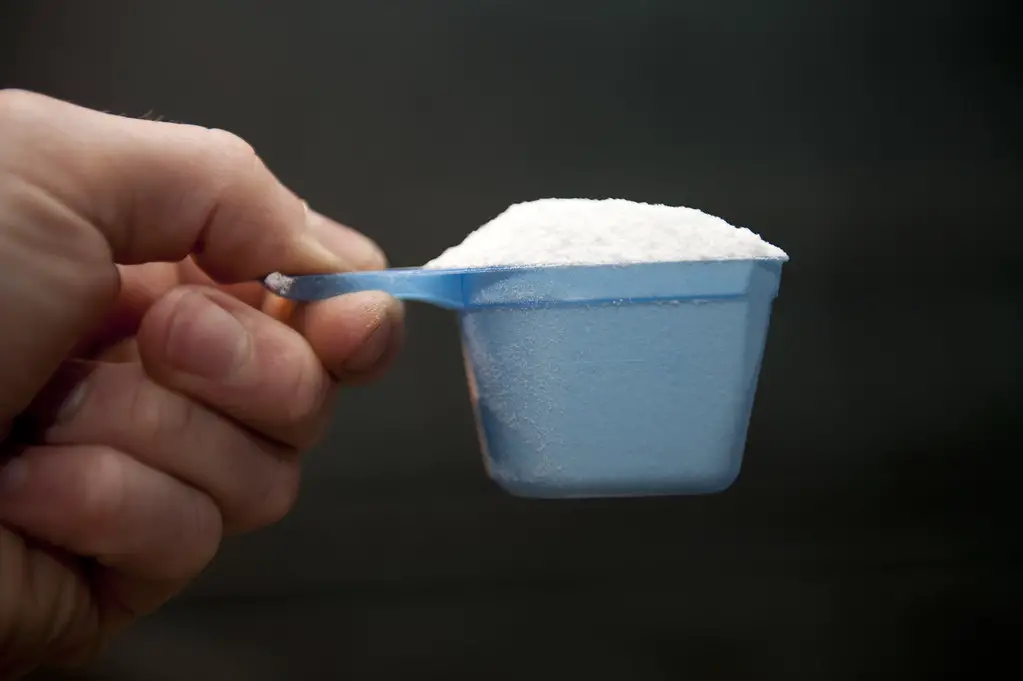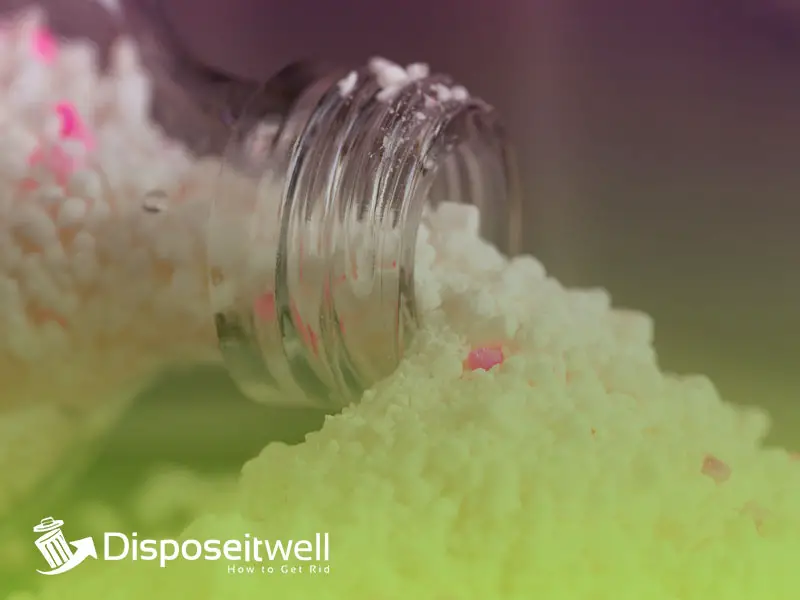If not handled properly, lye can cause serious harm. Lye, often known as caustic soda, is a highly soluble metal hydroxide. Sodium hydroxide, which is what most people mean when they talk about lye, has a high PH value (14). This means it is a reasonably robust base.
So, how do you get rid of lye water and crystals securely? Lye handling requires long sleeves, pants, goggles, and gloves, don’t mix lye with water, and avoid draining lye. This article highlights how to dispose of lye safely.
What is Lye? Is it Dangerous?
Metal hydroxide lye is commonly derived from extracting wood ashes or another strong alkali that is highly soluble in water and results in essential caustic solutions. Lye is widely utilized, particularly in industrial settings. This hydroxide is now produced commercially by a membrane cell chloralkali method.
It can be purchased in several different textures, from flakes and pellets to microbeads and coarse powder, or even as a solution. You’ll find it in many bar soaps because it’s a crucial component. While lye has its uses around the house, including drain cleaning, it is also quite hazardous. If not handled properly, it can result in severe injuries such as burns, blindness, and even death; If ingested, it can be deadly.
How to Dispose of Lye?
Contact your local waste management organization for information on correctly disposing of hazardous materials in your area. The disposal of lye must comply with federal, state, and local laws because of its classification as hazardous waste.

1- Having it Neutralized
Properly handling lye waste in this manner is still an efficient option, and understanding the potential risks will allow you to do the activity safely. As a result of a reaction between acid and alkali, salt and water are formed. The waste products of this reaction are inert and can be disposed of without concern. Since lye produces heat, neutralization reactions are dangerous. Extreme heat is frequently generated.
This is a recommended procedure for neutralizing lye.
- Always take precautions to avoid harm by using safety gear.
- Find a suitable acid that will effectively neutralize the lye.
- Use a low-pH acid because even trace amounts are enough to neutralize the highly caustic lye. Although acetic acid is safe to handle, a far larger quantity will be needed to neutralize the lye.
- Combine the lye and acid gradually in a big glass or metal container.
- Keep yourself out of the immediate fire and danger that will develop.
- You can now confidently toss this neutralized concoction in the trash or flush it down the toilet without worrying about harming yourself or the environment.
- Because it is no longer poisonous, you may be assured that disposing of it in a landfill or water body won’t cause any harm to the environment.
2- Adding water to it
Lye is an alkali. It can become neutral when combined with the right amount of an acid, like vinegar, but burning heat is generated throughout the process. Because vinegar, also known as acetic acid, is a dilute acid, a significant amount will be needed to neutralize even a small amount of lye. Instead, the calculated amount of water should be mixed with small amounts of lye first. Carry out this carefully and in modest amounts, as it may produce an exothermic reaction and generate heat. You can dump the lye down the drain after determining it has been diluted enough.
3- Disbursing It
It can take several weeks to safely dispose of excess lye in the drain if you have too much of it. Giving it to someone else who can use it would be a more preferable course of action. Many people in your area use lye daily since it is necessary for their jobs. These could be soap makers, a plumber, a shopkeeper, an engineer, or manufacturing workers. Giving them lye will prevent the waste of such a dangerous chemical, and you can simultaneously assist someone in need.
4- Wet Air Oxidation Procedure
The Wet Air Oxidation Method is a procedure that can be difficult to carry out. Still, it is most successful at transforming lye into a chemical that is not hazardous. It does not give off any scents and does not cause any toxic byproducts; thus, it is entirely harmless to the environment. Since lye is the primary energy source, this technique also has a low environmental impact.
Precautions for Disposing of Lye
Ventilation
Any noxious byproducts of lye disposal should be allowed to escape quickly to the outside air. When working with lye indoors, open all of the windows and doors. Fans can further improve air circulation.
Gear
Lye is a chemical that requires special precautions. Take all the protection you would typically take in a chemistry lab. Wear protective gear such as gloves, goggles, and a mask.
Keeping It Separate from Other Substances
Keep Lye away from everything else, as it is pretty reactive. It releases a great deal of heat when combined with water, and when combined with sugar, it can generate deadly carbon monoxide gas.
Proper Storage
To prevent injuries, lye should be kept in an airtight container when it is not in use.
Understanding the Emergency Procedures
When dealing with lye, it is essential to be prepared for any eventuality. If you come into contact with lye, immediately wash the affected areas with cold running water.
If you’ve been exposed to its vapors, get outside and take several deep breaths of air. Your top priority should be to get medical attention.
Precautions when handling lye
- Avoid disposing of lye in the regular trash. Also, avoid flushing it down the toilet, pouring it down the storm drain, leaving it on the ground, or putting it in your trash can.
- Protect yourself from lye using long-sleeved tops, pants, goggles, and gloves. Since breathing in lye dust or fumes might be harmful, you should always wear a dust mask.
- Lye reacts violently with water; thus, you shouldn’t mix the two. When water is added to the lye, a chemical reaction takes place, producing heat that can reach flammable or even explosive levels. Do not use water to flush the lye down the drain.
- When working with lye, exercise extreme caution. Keep it from dripping or splashing.
- Lye must be kept inaccessible to children and pets. Do not dump lye where children, animals, or unwary adults could come into contact with it.
- Put unused lye into the
- stainless steel trash can. Guarantee a secure cover for the storage container. Lye corrodes plastics, cast iron, iron, and aluminum; thus, you shouldn’t store or dispose of it in any of those materials.
Why Is it Necessary to Dispose of Lye with Care?
As its name suggests, lye can be highly acidic upon contact with most materials. If it comes into contact with your skin, you risk suffering severe burns and other injuries, including visual impairment and respiratory problems.
When added to any mixture, lye can induce extreme reactions. Therefore, careful disposal of lye is essential to ensure that it does not endanger anyone and that any potential dangers associated with it are mitigated.
FAQs
Is it OK to Pour Lye Down the Drain?
Clogs can be removed using a chemical drain cleaner. However, their effectiveness is problematic. While the cleaners may effectively remove the blockage, the acidic ingredients inside might eat away at the pipe itself.
It also doesn’t make a difference what kind of plumbing you have: Pipes made of plastic, steel, iron, copper, and galvanized iron can all be damaged by lye. Leaks caused by chemical drain cleaners are more expensive to fix than the clogs they are meant to remove.
Because of the chemical reaction that occurs when acidic compounds are introduced to plastic pipes, the pipe may melt or warp. Therefore, avoid pouring lye down the drain.
Is Lye Hazardous Waste?
If not handled correctly, lye can damage pipes and cause serious bodily harm. Burns from caustic drain cleaners can be extremely painful, and the harm they do can’t be reversed. The inhalation of the vapors produced by these items is also harmful to the lungs.
Verdict
The dangers of pesticide wastes cannot be overstated. Disposing of leftover pesticide, spray mixture, or rinsate in an improper manner is against the law. The trash that accumulates from using this product can either be thrown away on the premises or taken to a licensed dump. When getting rid of lye, make sure to do it properly.
My name is Ella Vicedomine and I’m the founder of this blog. The aim is to start this informational blog to guide people on how to dispose of waste things around in the house but in the right way.

